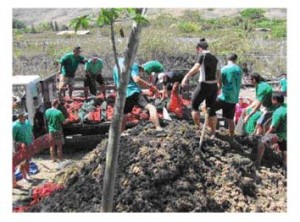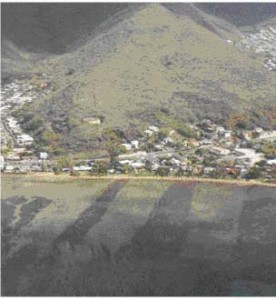Two million pounds of invasive algae removed from 16 acres in Maunalua Bay
Workers on Oahu will complete a milestone this afternoon, by removing 2 million pounds of invasive algae (leather mudweed) from 16 acres in Maunalua Bay. The invasive algae is being used by a local farmer, nursery an non profit organization for compost to grow produce, crops and plants. The work was made possible by a federal stimulus grant and is scheduled for completion in February.
ma

Volunteers gather the invasive algae for a composting project. Photo credit: Kimo Franklin/Malama Maunalua.

Two million pounds of invasive algae have been removed from the 16 acres in Maunalua Bay, shown above. Photo credit: Manual Mejia/TNC.
“Together we’ve created jobs, helped educate people, generated enthusiasm and conducted real, science-based conservation in a place everyone cares about,” said Suzanne Case, Director of The Nature Conservancy of Hawai‘i. “I am so proud of our collective partnership and that the Conservancy has been able to help facilitate this project.”
In addition, a joint research project on converting the algae into a compost product is being conducted at Aloha ‘Āina ‘o Kamilo Nui (at Chrysanthemums of Hawaii), a non-profit organization that has provided space on its farm in Kamilo Nui Valley. Mālama Maunalua is partnering with Aloha ‘Āina ‘o Kamilo Nui, The Nature Conservancy, Pono Pacific and the University of Hawaii’s College of Tropical Agriculture and Human Resources (UH CTAHR) to test the best ways to convert the invasive algae into compost. ‘Uala (sweet potatoes) have been planted using the compost, and compost piles are being tested to determine the most efficient and quickest way to break down the invasive algae to make a viable soil amendment or compost for farmers, landscapers and the community at large to use.
“By healing the ocean we can also heal ourselves and our island. We are putting nutrients back into the soil and creating new possibilities for sustainability in the island by growing food right here in Maunalua with something that was damaging our ocean,” said Kimo Franklin, Malama Maunalua’s Community Huki Site Coordinator.
In years to come, scientists will monitor and support the return of native seagrass and marine life. Volunteers will continue working to remove invasive algae. And Malama Maunalua will continue working with community members, fishermen, residents and other organizations to tackle the remaining challenges: land-based sediment and pollutants, and unsustainable harvesting of marine resources.










